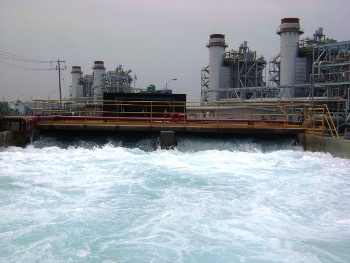The Combined-Cycle Power Plants of Global Power Generation in Mexico continuously operate with very high capacity factors due to a certain level of surplus capacity; i.e. the difference between the maximum output that can be produced and the long-term contracted power contract with the Comisión Federal de Electricidad (CFE).
In order to increase surplus capacity and net revenue from the sale of electricity, GPG has analysed the technologies available in the market for increasing power by conducting technical-economic feasibility studies on the installation of various equipment.
The Tuxpan Combined-Cycle Power Plant, located in the State of Veracruz, consists of two blocks (III and IV) with each one formed of two Mitsubishi 501F gas turbines followed by two heat recovery boilers and one standard steam turbine. The main cooling system consists of an open circuit that uses sea water. The plant is located at sea level on the Gulf of Mexico, which results in some high temperatures and high humidity levels. Each unit has an installed capacity of 500 MW, with a variation between summer and winter conditions of some 40 MW.
At the start of February, both blocks at the plant were shut down for maintenance purposes. Based on the profitability of each alternative studied and the feasibility of implementing the modifications required for each alternative during the scheduled shut-down, it was decided that the best solution for the Tuxpan Power Plant was to install a High Fogging system, which has already been implemented at the Hermosillo Plant.
How does a High Fogging system work?
An increase in ambient temperature causes a reduction in air density. The gas turbine compressors, which turn at constant revolutions, have little capacity to compensate for this phenomenon and this leads to a reduction in the air mass compressed. This means a lower injection of oxygen into the combustion chamber and a corresponding reduction in power.
A High Fogging system manages to cool the air being drawn into the gas turbines and therefore increases its density, thereby recovering part of the power that is lost due to the effect of higher ambient temperatures. The water is sprayed from a series of high-pressure injection jets distributed uniformly across the cross-section of the compressor air input conduit, after the input filter.
The system will enable the power output from the combined-cycle plant to be increased; specifically, by 15 MW per gas turbine, approximately 56 MW net total at the plant. In addition, the technologist is expected to make modifications to the gas turbines in 2018 (Tuxpan III) and 2019 (Tuxpan IV) that will increase the output they produce but will, to a certain extent, limit use of the High Fogging system.
Towards ongoing efficiency improvement
The goal is to increase the installed capacity in Mexico while maintaining a relatively low unit cost per kW, increasing GPG’s share of this energy market. To do so, considerable work has been carried out on the study, design and implementation of the system, with close collaboration from the Global Power Generation teams at the power plant, GPG Operaciones e Ingeniería-Construcción (IDG) and the chosen contractors.
The next steps in the project consist of completing the installation of external parts of the water injection system, proceeding with the supply and installation of a new water plant, and interfacing these systems with the plant and its control systems. Subsequently, all the components will be tested and started up in order to begin operating at the end of 2017.
Looking forward, similar studies have been developed for the Norte Durango, Hermosillo and Naco Nogales power plants, identifying the most suitable solution for each one. Given that the current climate seems favourable to the profitability of these projects, it is hoped that similar projects may be launched at these plants in the near future.

